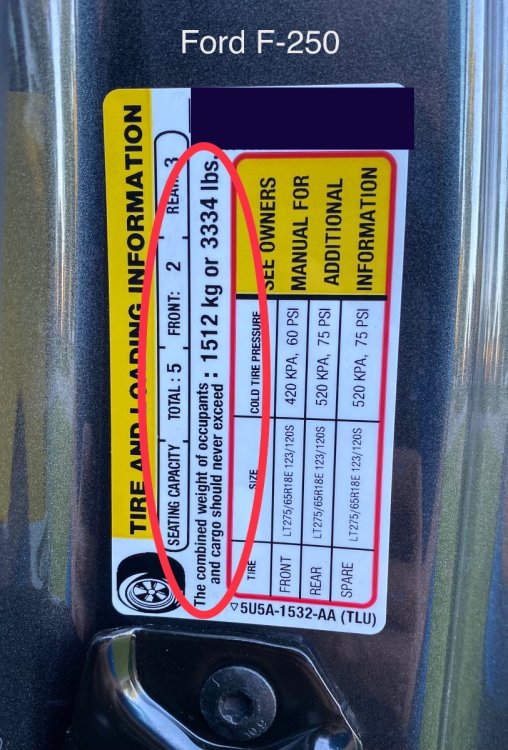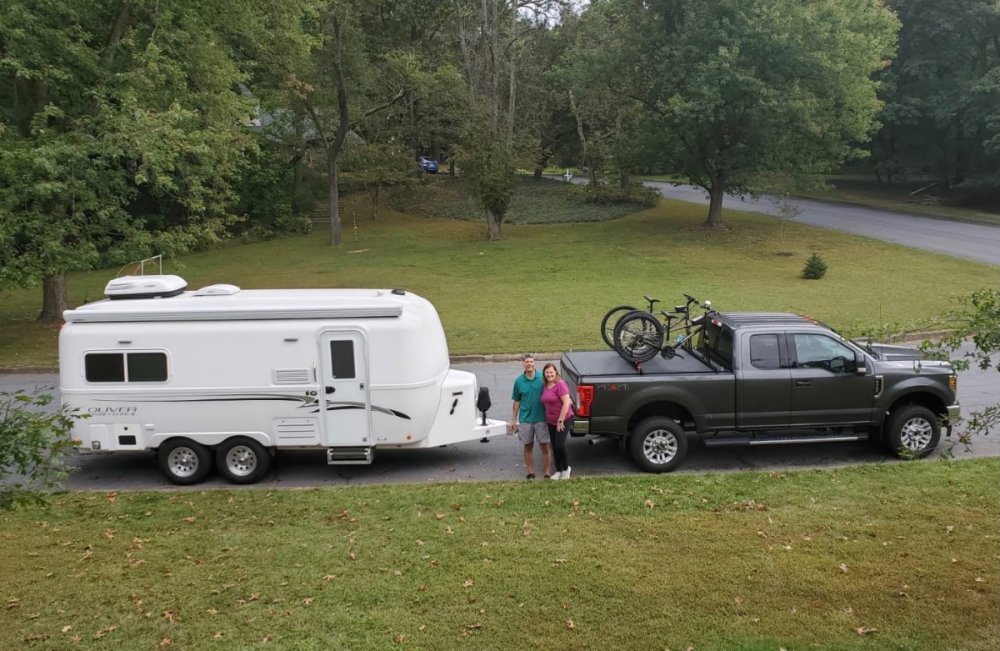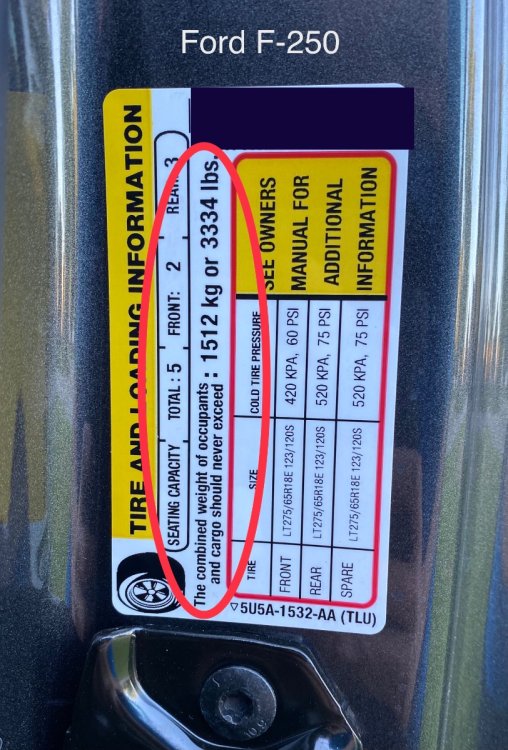-
Posts
781 -
Joined
-
Last visited
-
Days Won
18
Everything posted by Frank C
-
I’m surprised you are still noticing any strong “glue like smell” on a 6 to 7 year old trailer. Everything should have outgassed long ago. The “new Oliver trailer smell” of fiberglass resin & adhesive was gone from our Ollie after about 6 months or so. You may want to thoroughly check all the systems (plumbing leaks, electrical/batteries, etc.) and make sure there isn’t something still generating that odor. If you are using any type of chemical treatment in your black or gray tank it could be a leak & odor from that. We had an odor issue under the dinette seats that ended up being a broken toilet mounting flange that was leaking very slowly onto the top of the black tank and between the hulls. Thankfully we don’t do #2 in the trailer bathroom, #1 only, so cleanup and installing a new toilet flange wasn’t too bad of a job. #2 is done at roadside rest stops and at campground bathrooms. Never had any other odor issues since then.
-
I don’t have the factory solar package (but I do have the wiring), so not sure if this will help, but there is the master DC 60 amp breaker and another smaller 20 amp resetting breaker (under the red rubber cover), for the DC circuits under the street side bed that you can check for proper voltages as part of your troubleshooting.
- 1 reply
-
- 1
-

-
I should have mentioned that I have the good old fashioned lead acid wet cells.
-
We have chlorinated city water at our house so when we get home after camping trips I drain the fresh water tank to empty out any water left from our last campground hookup, then I run our house water through the trailer city water connection to flush all the faucets and toilet, then I fill the fresh tank, drain it, then fill it again and run all the faucets again using the trailer onboard pump. This gets our chlorinated house water into all the trailer lines (and I leave the fresh tank full with our house water). I repeat this process once a week or so, including draining and refilling the fresh water tank if the trailer is sitting at home for any length of time between trips to keep the water fairly fresh. I also plug into shore power about once a week at home to keep the trailer batteries charged, and I get the propane tanks refilled. It’s easy to do (I have quick connect hose couplings on all of the trailer water connections) and this way I have a 30 gallon emergency fresh water supply at the ready if anything happens at the house with city water being turned off due to borough water line maintenance, etc. Plus the trailer is ready to go on short notice if needed (think of the situation of the folks in East Palestine Ohio that had to evacuate after the train derailment). I like being prepared for emergencies as much as possible, and a stocked & ready Ollie provides a good backup for a lot of situations. We do drink and cook with the water from our fresh water tank while camping, but we always use a multistage filter system. I do winterize as recommended during winter months, and I do the bleach sanitizing process in the spring after de-winterizing.
-
This would make backing up almost impossible because of the extra added hitch connection between the tow vehicle and trailer, plus the extra length. The patent mentions a stability function while towing but unless it includes some incredible computer assisted smarts to also help with backing up while connected to the tow vehicle, this wouldn’t be practical. The one diagram shows a person using this tow assist as a trailer valet but having to unhook and do that every time you needed to back up would be a pain.
-

Truma Aqua-Go owners: What Real-Use Settings Do You Use?
Frank C replied to Steve Morris's topic in General Discussion
We leave it OFF most of the time while camping and only turn it on (COMFORT mode) a bit before we want to take our showers. Keeps the propane usage to a minimum. I also don't like leaving propane on if we are away from the camper for sightseeing/day trips, so when we leave the camper, the Truma is off and I close the propane tank valve. We typically camp at full hookup campgrounds so the fridge is running on AC. If you leave the Truma in COMFORT mode it uses more propane and it gets annoying at night hearing the Truma cycle on and off frequently to keep hot water at the ready. I should add that we rarely camp in cold weather. We are 3 season campers, spring, summer and fall. -
I had a somewhat similar problem with the bypass valve. Turned out to be degradation of the seal inside the valve. Seems that some of the winterizing or disinfecting solutions can attack the seal material in the valve It’s an easy replacement Link to the old thread discussion below.
- 1 reply
-
- 5
-

-

-
Looks like this owner lucked out. It was denied as a warranty repair by the factory because he exceeded his payload number, but his insurance (GEICO) covered the broken frame, even though he finally admitted he was over his payload rating for his specific truck. Another example of why you should never trust what the dealership/salesman tells you about the towing/payload ratings. https://www.truckcamperadventure.com/insurance-covers-repair-to-pavels-overloaded-and-broken-ram-3500-frame/
-
This is the ball mount and ball I’m using on my F-250. I do not use the Andersen hitch. It is not required or recommended for my F-250 specs. I have used the Andersen hitch on previous tow vehicles that required it, and I’m much happier now having a truck that does not need it. A “3/4 ton” truck like an F-250 is a great match for the Elite II. Specs for my F-250 are 12,600 pounds towing, 1,250 lbs tongue weight, 3,334 lbs. payload rating, so a very nice safety margin with the Elite II. My F-250 isn’t a Tremor edition though so your specs may be different. My F-250 has a 2-1/2” receiver socket. The 3” drop ball mount puts the Oliver nice and level when towing with my truck. Draw-Tite 45322 3" Drop Ball Mount https://a.co/d/1tvHOA8 CURT 40056 Stainless Steel Trailer Hitch Ball, 10,000 lbs, 2-Inch Diameter, 1-1/4 x 2-5/8-Inch Shank https://a.co/d/5zjdsM5
-
So from that 1,390 pound payload limit, subtract the Elite I tongue weight of 400 to 500 pounds, then subtract the weight of 3 adults (500 to 600 pounds), and subtract the weight of the Andersen hitch (~50 lbs.), subtract the weight of Rock Tamer mud flaps if you add those to the hitch (~50 lbs.), then subtract the weight of EVERYTHING ELSE that’s ever been added in or on your tow vehicle (floor mats, mud flaps, cargo liner, tools, etc.) and that gives you the remaining payload number left for your camping gear. It gets used up surprisingly fast when you honestly count the weight of EVERYTHING that wasn’t in or on the vehicle from the factory. We started towing our Elite II with large body-on-frame SUVs (a Ford Expedition EL with HD tow package first, and then a Nissan Armada). On paper, both were fully capable of towing the Elite II (both did require the Andersen WDH), but the reality for camping was not ideal. And the EcoBoost V6 engine in the Expedition felt overworked when towing in the mountains. We carry a lot for extended road/camping trips, and while both those SUVs had plenty of cargo/payload weight rating (around 1,700 lbs.) and towing capacity, the reality was that cargo VOLUME became a bigger issue for long camping trips. We carry two camp chairs, a 9’x12’ outdoor rug, a folding picnic table, a drying rack for clothes, a portable grill, an extra 20 lb. propane tank, tools and emergency roadside gear, two bicycles, an ice filled cooler, portable solar panel, etc. so I was getting close to the payload weight limit and also just ran out of space in those SUVs. We now use a Ford F-250 and no more worries. Towing and camping are much more enjoyable now.
-
Best not to put phone numbers or email addresses of people in posts on the forum. There are a lot of scammers/spammers that look at this site searching for personal info. Send that type of information through a direct message to the intended person.
-
Probably would have been better to break the “KIA as a tow vehicle” suitability discussion off into a new separate topic thread. Right now this new revised thread title has no relationship to the subject of the original post.
-
Does Oliver have any responsibility or give any input when a new owner shows up on delivery day with an undersized/unsafe tow vehicle? We’ve seen owners towing with unsuitable vehicles, overloaded with respect to towing rating or payload, using a WDH when it’s contraindicated with certain uni-body SUVs, or not using a WDH when they should be, some with no trailer brake controller, etc. Maybe in this case (or the others noted), the trailer was bought used? So no input from Oliver, just from the previous owner?
-
Ding! Ding! Ding! We have a winner. Here’s a pic of the Telluride. Notice the roofline above the windshield, and the chrome trim above the door handle on the B pillar. Based on the published specs for the Telluride, it’s a really bad choice for towing an Elite II considering that the empty dry weight of an Elite II with no options at all is 4,900 lbs.
-
If you’re asking about my installation, the screws just came from Lowe’s as “stainless”, no mention of what grade or type of stainless. And I don’t recall the length, probably 1/2” or 5/8”. The Husky mud flaps are pretty thick, plus the thickness of large diameter stainless flat washers and lock washers (and I used LocTite as well on the threads. I didn’t want the mud flaps coming loose! 🙂). But you are correct, the right length is important to prevent the screw from bottoming out in the aluminum T slot extrusion before it actually clamps down on the mud flap or the frame cross rail.
-
When we were given our Hull #461, the name “Ocean Boulevard” immediately came to mind. Haven’t gotten around to putting a palm tree decal on the trailer yet though. And I don’t want to call the trailer “Eric” 😂.
-
What the heck!?!? Are those the original tires on the Ollie? Looks like a chunk of the tire was actually cut away.
-
My Elite II has 1-1/2” axle spindle nuts.
-

Surge protector "clunk"..no 120
Frank C replied to Gliddenwoods's topic in Mechanical & Technical Tips
The voltage number will vary a bit depending on the shore power. Normal AC shore/household power voltage is usually in the range of 110 to 125 volts. AC shore power frequency (the H value) is usually controlled very tightly by power companies and should always read 60 Hertz, so the shore power voltage and frequency are not the problem. It’s odd that the Progressive unit in your trailer is showing E0 (normal/no errors) but your external surge protector at the post is showing a reversed line-neutral problem with the shore power. That reversed line (hot) and neutral wire error should be showing an E1 error on the Progressive display. -

Surge protector "clunk"..no 120
Frank C replied to Gliddenwoods's topic in Mechanical & Technical Tips
What else is showing on the Progressive display besides the E0 (normal, no error) message? Is it showing a voltage, frequency (the H Hertz number), and amp value (the A number)? -

2023 LE II Trailer Weight (Dry), all Oliver options, empty
Frank C replied to JDAstroPhoto's topic in General Discussion
We always travel with a full fresh tank as well, so we have water for rest stops on the road, and also to be prepared if the destination campground has water quality or availability problems. I like being prepared, and a well stocked Ollie can provide shelter, food and water for an extended time. -

2023 LE II Trailer Weight (Dry), all Oliver options, empty
Frank C replied to JDAstroPhoto's topic in General Discussion
Murphy’s Law always applies! 🙂 -

2023 LE II Trailer Weight (Dry), all Oliver options, empty
Frank C replied to JDAstroPhoto's topic in General Discussion
Hi Steve, that’s a very loose interpretation of Newton's law. And that example of the extra weight of full tanks only applies in an ideal world with frictionless surfaces. Frictional forces must always be taken into account in the balance of forces with Newton's laws. In that cartoon illustration, the frictional force of the crate sliding on the floor must be accounted for. The crate won't keep sliding on its own. You have to keep pushing, even to maintain a constant speed. And the heavier the crate, the harder you have to push to maintain a constant speed, because the frictional force increases in direct proportion to the weight. In the real world, every extra bit of mass in the trailer and tow vehicle absolutely will require additional energy to move, even at a constant speed on a level road, for several reasons: -Rolling resistance of the tires increases as the downward loading on the tires increases. -Wheel bearing friction, etc. all increase as well as the mass increases. -Even when towing at a constant speed on a level road, a change in direction (making a turn) is a change in velocity vector (which is still an acceleration) that requires more energy as the mass increases. And of course we don’t drive indefinitely on level roads at a constant speed. There are hills, stop lights, etc. that constantly require acceleration, so more mass means more energy needed. -

Tow Vehicle, 6'4" vs 8' box, Crew vs Mega, DA vs SA
Frank C replied to JDAstroPhoto's topic in General Discussion
I wanted a very capable but still somewhat compact truck as a tow vehicle so I went in the opposite direction of your thinking. I found an F-250 SuperCab (rear suicide doors) with short (6’-9”) bed. It’s only my wife and me when we travel, and this truck keeps the overall length a bit more reasonable for maneuvering around with the truck, but still has a lot of room in the cab and the bed, and huge towing and payload capacity. The SuperCab has no door pillar between the front and rear doors when the doors are open, so it’s very easy access to the rear seats. We do a lot of day trips with the truck after setting up the camper at the campground, so I wanted something at least a little more “compact” (a relative term when we are talking about a 3/4 ton truck 🙂) to make it easier to get around in downtown areas, parking lots, narrow roads, etc as we do our exploring during the day. -

Bill and Nancy's towing vehicle issues
Frank C replied to Bill and Nancy's topic in Towing an Oliver
I think the "issue" being raised (and it's a valid issue) is that as Bill is doing his weight calculations and assumed safety margins, he is mixing up towing capacity and payload capacity. They are not the same thing. He has mentioned the towing capacity rating of 7,700 lbs. but then is using that number to calculate how much load he can put IN the truck instead of using the cargo/payload number from the truck door jamb sticker.

















